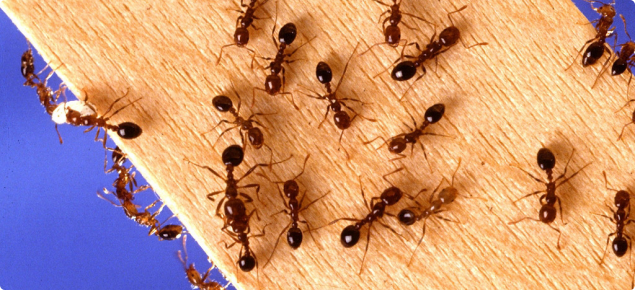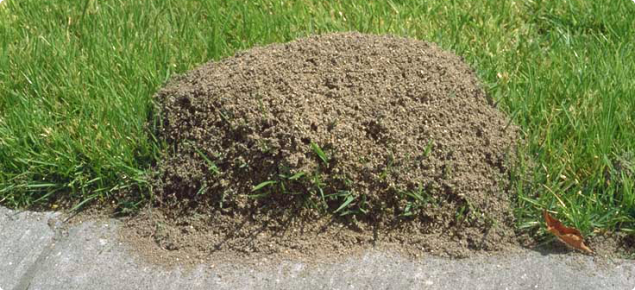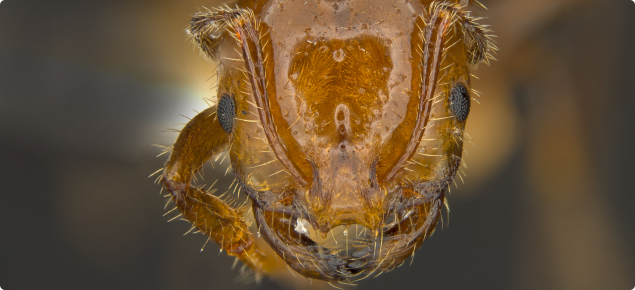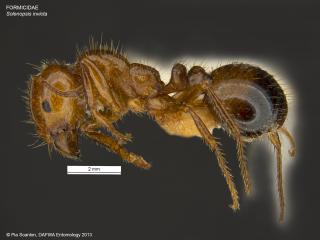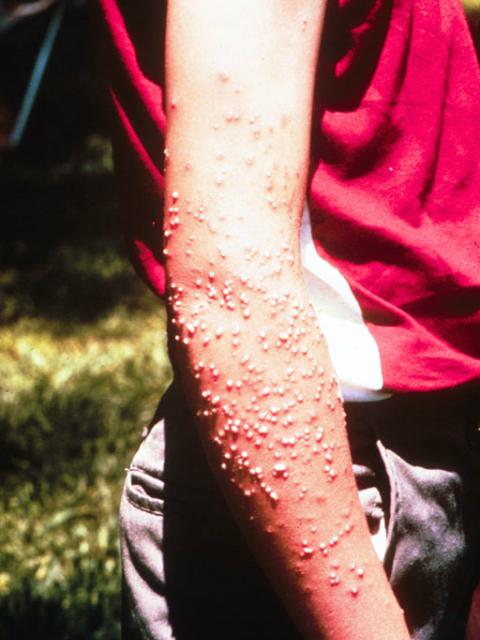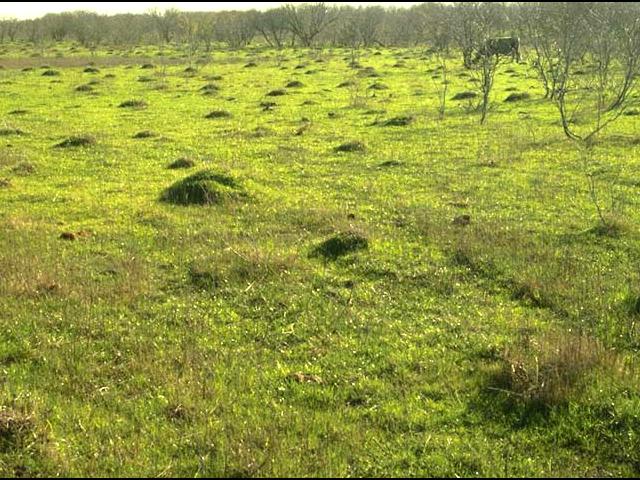Overview
Red imported fire ant (RIFA), Solenopsis invicta, is a serious threat to Western Australia and has already established in south-east Queensland.
This is a prohibited organism in Western Australia under the Biosecurity and Agriculture Management Act 2007 (BAM Act).
The invasive ant pest was first detected at the Fremantle Port in November 2019 as part of the surveillance being undertaken for the National Browsing Ant Eradication Program.
A 2-year comprehensive eradication program was undertaken by the Department of Primary Industries and Regional Development. This included six rounds of visual surveillance involving hand collection, lures, pitfall traps, and the use of specifically trained odour detection dogs from Queensland.
As part of the eradication effort more than 3,500 premises, including container and ferry terminals, industrial properties, fishing wharves, parks and recreational spaces and residential properties were inspected multiple times, with over 14,000 samples collected for identification.
Support and co-operation from Fremantle Port and their tenants, the City of Fremantle, Town of East Fremantle, local residents and businesses during the surveillance, baiting and quarantine activities was crucial to the success of the response.
Western Australia was declared free of red imported fire ant on 21 October 2023.
It is important that any further detections of RIFA or any unusual animal or plant pests or diseases are reported immediately via the MyPestGuide Reporter ® app so that the pest can be contained and eradicated efficiently and effectively.
RIFA could be accidentally imported into Western Australia in items such as pot plants, hay, bee hives, turf or shipping containers.
It has the capacity to form 'super colonies' with multiple queens and can spread rapidly and develop extensive colonies.
These ants are opportunistic feeders that are omnivorous and prey on invertebrates, vertebrates and plants. They destroy seeds, harvest honeydew from specialised invertebrates and also scavenge. This action can affect the whole ecosystem.
They also compete with native herbivores and other insects for food. For example, some ground-dwelling native bees and Thynid wasps are very 'species-specific' and only pollinate native terrestrial orchids. RIFA feeding on the orchids competes with the native bees and wasps, disrupting the natural pollination of these plants.
Being omnivorous, fire ants may prey on other plant feeding insects (phytophagous arthropods) associated with various crops.
Worker ants also feed on certain seeds and plants, and are attracted to nectaries on plants such as cotton and passion vine.
On other plants, they are attracted to oil-containing parts such as the embryo portion of corn and sorghum seeds.
Appearance
![Red Imported Fire Ant size range Red Imported Fire Ant size range [in a circle] – queen far right.](/sites/gateway/files/styles/banner_image/public/antsizes_2.jpg?itok=f64Tj7Dt)
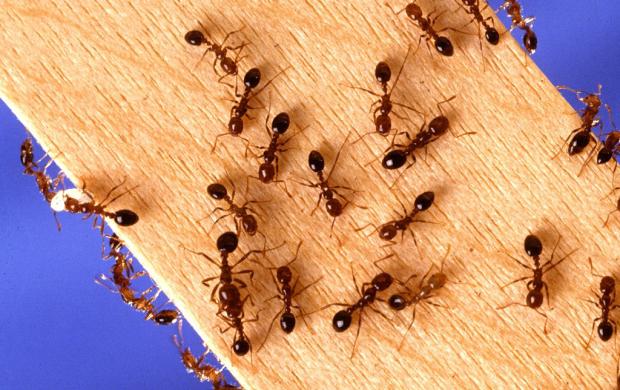
RIFA mounds
Fire ants build characteristic mounds of 'fluffy' friable soil that are low and squat, up to 40cm high and 50–75cm across. New mounds start as small piles of excavated soil and may be indistinguishable from those of many other ant species.
The mounds are built in open areas such as lawns and verges, sports grounds, golf courses and pasture paddocks and may number more than 100 per hectare. Mounds are unique in that there are no obvious ‘entry’ holes.
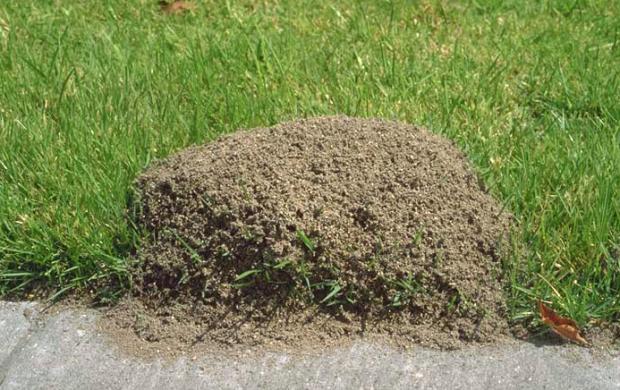
Damage
The red imported fire ant is primarily an urban and human health pest, but also has significant impact on agriculture and the environment.
It is declared a ‘Key Threatening Process’ under the Federal Environment Protection and Biosecurity Conservation Act.
In the USA, where this exotic species is widely established, it is estimated to cost more than $5 billion annually in damage and control.
RIFA thrives in backyards, school grounds, golf courses and street verges and because of its aggressive stings deters outdoor activities. The ants commonly invade houses and can injure pets if these are tied, penned or caged and unable to escape.
The ants chew through electrical insulation resulting in extensive damage to electric motors, air conditioners, pumps, transformers, telephone exchanges, signal boxes and other devices.
In the process of nest and mound building, they can excavate so much soil that structural problems result under paving, driveways and retaining walls.
Health effects
In the USA, it is estimated that 33 000 people a year seek medical attention for RIFA stings. Severe cases require hospitalisation, and allergic reactions can result in death, although this is rare. The cost to the community is significant especially when worker’s compensation is included. Permanent scarring can result from stings.
Agricultural significance
In agriculture, these ants have been recorded directly damaging many plants from potato tubers to young citrus trees killed by ants girdling the stems.
They collect seeds, feed on germinating seeds and seedlings, and on developing fruits and buds. Scale insects and aphids are tended and protected, resulting in severe infestations requiring insecticides.
The ants frequently cause problems in reticulation systems. Activity in paddocks can deter workers from harvesting fruits and vegetables. Numerous ant mounds, sometimes exceeding 400 per hectare, can interfere with hay cutting and make the simple act of driving across farm paddocks difficult.
Livestock can be deterred from feeding and the area occupied by mounds can reduce available pasture significantly. Animals in pens, feedlots or high-intensity production systems can be attacked.
Ecological impact
RIFA feed on a wide range of plant and animal materials. They are aggressive predators and have a major negative effect on ground-active and nesting animals from insects to frogs, reptiles, birds and mammals.
Populations of mice, snakes, turtles and other vertebrates have halved as a result of infestation. Native flora can be adversely affected by them feeding on plant seeds.
Eradication from Australia
The National Red Imported Fire Ant Eradication Program formally commenced in September 2001, building on an emergency response after its discovery in February 2001. The program is funded by all Australian states and territories as well as the Commonwealth Government.
The program aims to eradicate this pest, building on expertise shared by international specialists. It is discovering patterns of ant activity and developing new ways to beat them as new challenges arise.
As well as scientific and operational innovation and effort, community support is crucial in the fight to eliminate fire ants from Australia. Following the 2019 detection at Fremantle, the support and co-operation from the Fremantle Port and their tenants, the City of Fremantle, Town of East Fremantle, local residents and businesses during the surveillance, baiting and quarantine activities has been crucial to the success of the response.
Reporting
LOOK AND REPORT!
Please report any unfamiliar ants immediately – even if unsure.
Do not disturb ants as they may aggressively defend the nest.
Suspected RIFA are:
- small, golden to reddish brown ants 2-6mm long
- very aggressive when disturbed
- able to inflict painful stings (pustule formation at sting sites blisters) and sting repeatedly.
Suspected RIFA mounds would be:
- multiple ant mounds in urban or developed areas
- up to 40cm high and generally dome-shaped
- absence of entry and exit holes.
Take photographs if safe to do so.
Contact the department via:
- MyPestGuide Reporter app
- MyPestGuide website
- DPIRD’s Pest and Disease Information Service +61 (0)8 9368 3080
- padis@dpird.wa.gov.au

